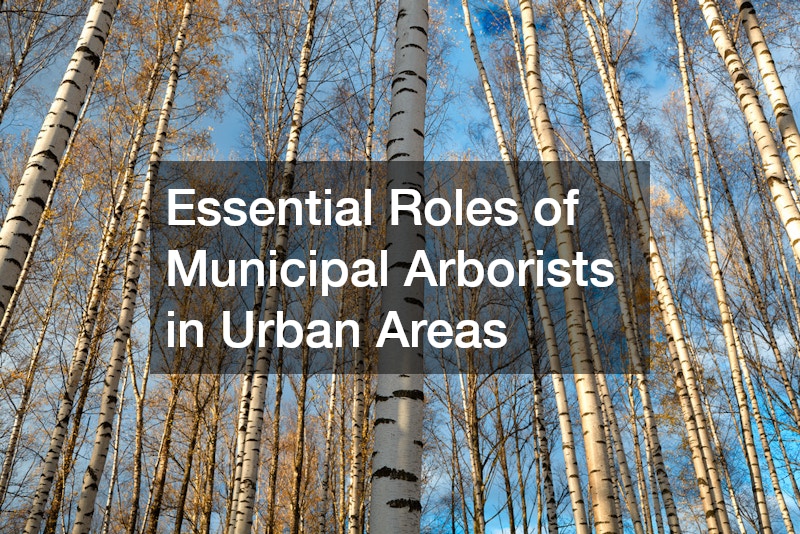
Urban areas across the world are facing unique challenges as they try to balance development with ecological preservation. Amidst this ongoing balancing act, the role of municipal arborists has never been more critical. Municipal arborists are specialized professionals who manage and care for urban forests, ensuring that trees continue to provide vital benefits to city dwellers.
Video Source
This article explores the multifaceted roles of municipal arborists and highlights their indispensable contributions to sustainable urban living.
Municipal arborists are at the forefront of urban tree planting initiatives. They meticulously select tree species suitable for the urban environment, taking into account factors like climate, soil quality, and available space. These experts ensure that the right trees are planted in the right places, optimizing growth and minimizing risks. A crucial aspect of their work is to regularly monitor the health of these trees, which involves scheduled inspections and maintenance practices like pruning. Their work ensures that urban trees can thrive while providing shade, reducing heat islands, and beautifying the cityscape.
The maintenance responsibilities of municipal arborists extend beyond just planting. They implement health assessments that help to identify diseases or pest infestations early. By diagnosing potential problems before they escalate, arborists prevent health risks that compromised trees might pose to residents. Additionally, through the use of technology such as Geographic Information Systems (GIS), arborists can maintain up-to-date data on urban tree populations. This proactive approach aids in the efficient allocation of resources for maintenance and management, ensuring that urban trees remain robust and resilient.
Municipal arborists play a pivotal role in mitigating environmental challenges specific to urban areas. Trees planted and maintained by arborists help in reducing the urban heat island effect, which can make cities significantly warmer than their rural surroundings. By offering shade and cooling surfaces through evapotranspiration, these trees contribute to lower energy consumption for cooling purposes. Additionally, they work towards fostering biodiversity in urban areas by creating habitats that support various species of wildlife. Therefore, arborists are crucial to maintaining the ecological balance within cities, providing shade and comfort to both humans and animals.
Beyond environmental contributions, municipal arborists address social challenges within urban communities. Trees create spaces that promote physical and mental well-being, increasing opportunities for community interactions. Municipal arborists collaborate with urban planners to design green spaces that are accessible and beneficial to all community members, enhancing social cohesion. Their work promotes inclusivity by ensuring urban green spaces are equitable and available across different neighborhoods. By positively influencing urban living conditions, arborists play an integral role in fostering healthier and more resilient communities.
Municipal arborists are integral in the development and implementation of urban forestry policies. They collaborate with policymakers to establish guidelines and standards that govern tree management practices within city limits. Their expertise is essential in ensuring that policies are both scientifically sound and practical, addressing the unique challenges of urban environments. Arborists advocate for policies that prioritize the preservation and expansion of urban green space, enabling cities to adapt to climate change more effectively. Through their contribution, cities can develop resilient infrastructure that supports both ecological sustainability and population growth.
The implementation of urban forestry policies requires a multifaceted approach. Municipal arborists coordinate with various city departments to ensure that tree-related ordinances are enforced. They oversee the compliance of development projects with tree preservation laws, ensuring that urban expansion does not come at the cost of ecological damage. Arborists also work with non-profit organizations and community groups to mobilize resources for tree planting and maintenance programs. This collaborative effort ensures that urban forestry initiatives are both comprehensive and community-driven.
As urban areas continue to grow, the role of municipal arborists is set to become even more significant. Looking to the future, these professionals will increasingly rely on technological advancements to monitor and manage urban forests more effectively. Technologies such as drones and remote sensing are already being utilized to assess tree health and coverage, making arboriculture practices more efficient and proactive. This technological integration is vital for adapting to climate change and urban expansion challenges. By staying at the forefront of technological advancements, municipal arborists will continue to enhance the scalability and impact of urban forestry initiatives.
Future trends also indicate a growing emphasis on collaborative urban forestry strategies. Municipal arborists will likely engage even more with public and private sector stakeholders to design and implement innovative green infrastructure solutions. New partnerships can lead to the development of urban areas that prioritize sustainable living, where green spaces are integrated within infrastructure planning. By fostering collaborations, arborists can leverage a wider range of expertise and resources to further urban forestry objectives. This approach will ensure that urban forestry continues to adapt to emerging challenges while meeting the needs of urban populations.
In conclusion, municipal arborists are essential custodians of urban forests, championing the integration of nature within city landscapes. Their diverse roles, from tree planting and maintenance to policy development and community engagement, highlight their critical importance in addressing the environmental and social challenges of urbanization. As we face an uncertain future, the knowledge, skills, and dedication of municipal arborists will be crucial in ensuring our cities remain sustainable, healthy, and vibrant. Their work not only enhances urban living but also contributes to a resilient and balanced ecosystem for future generations. Embracing their expertise is key to safeguarding the planet's health and ensuring economic viability for urban settlers.
